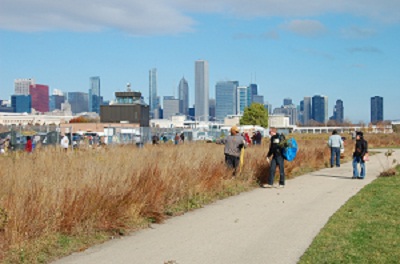With Earth Week here we know many of you are celebrating with events and other activities that engage your community in conservation. This is phenomenal! You know, NRPA believes that core to the mission of public parks and recreation is the preservation of natural resources and the promotion of good conservation and stewardship practices – this is one of our “Three Pillars.” And this isn’t just during this week or just in April, we know you are taking the lead and making a difference in conservation all year long.
But you know, sometimes you need a little conservation inspiration. Ideas to help get the "green" in you going. What better way than by giving you a glimpse of how one agency did something creative to lead a conservation initiative in their community this past year. The following story comes from Mitchell Murdock, Natural Areas Manager of the Chicago Park District, Department of Natural Resources. Mitch shares how and why the Chicago Park District conducted a native "plant rescue" and also provides key ways to make an event like this a success. We hope this innovative idea helps sparks the spirit of conservation in you all year long.
This past fall, the Chicago Park District held two “Plant Rescue” events to give away native plant material to the public, free of charge. The events were held on consecutive Saturdays, October 27 and November 3, 2012. Both days were well attended by community members from across the Chicago Region, and totaled over 400 attendees from nearly 40 different zip codes. The event was organized and facilitated by Chicago Park District and their partners: The Field Museum, Audubon- Chicago Region, Openlands, and Greencorps. Staff from these organizations were on hand to help identify and dig up native plants for community members to take home and plant in their yards. Tools, bags and pots were all provided by the event organizers. The only thing the public needed to bring was a desire for native plants and a little ambition.

Attendees at the Native "Plant Rescue" hunt for plants to dig and take home
Promoted as “Plant Rescue” events, the free plant giveaways were held at Northerly Island, a peninsula of parkland that juts out into Lake Michigan adjacent to Chicago’s Museum Campus. The park is the site of a capital project where the Army Corps of Engineers will be leading a large-scale (roughly $5M budget and 40-acre area) habitat restoration project which will require a complete reconstruction of the existing natural area site, and the native plants on site will not be able to be retained. The project will create a variety of ecosystems, including a prairie, savanna, marsh and pond. The finished product will provide higher quality and more diverse natural areas for flora, fauna, and visitors to enjoy.
However, as part of the earth moving efforts needed to reshape the landscape, it is not possible to reuse any of the existing native plant material. The "Plant Rescue" presented a perfect opportunity to get the public out in the park and learn about native plants and the ecological restoration project that will be taking place, all while providing them with their own piece of the prairie to take home and care for.
The plants in greatest abundance were Little Bluestem (Schizachyrium scoparium), Side Oats Grama (Bouteloua curtipendula), New England Aster (Aster novae-angliae), Grey Headed Coneflower (Ratibida pinnata), Stiff Goldenrod (Solidago rigida), and Wild Bergamot / Bee Balm (Monarda fistulosa). However, many of the native plant enthusiasts who attended were also able to find, identify and take home rarer species such as Purple Prairie Clover (Dalea purpurea).
In reflection, the event was well-received and well-attended by the public thanks to several contributing factors:
- Notification of the upcoming event was widespread, as the Chicago Park District and their partners used many different forms of media to get the word out, including websites, email lists, newsletters, press releases and various forms of social media. It was vital to be able to tap into a network of partner organizations with such a broad reach.
- Many attendees were drawn in by the prospect of getting something for free. Both plant enthusiasts and novices alike were excited about the opportunity to take home some native plants.
- Handouts were given to all attendees. The handouts provided photos and concise information about the plants, including common name, species, characteristics and requirements, helping everyone to identify several of the more abundant species. The handouts also provided a link to more information on the capital project, and a list of the plant rescue partner organizations.
- Lastly, the event really encouraged and rewarded those who were willing to pick up a shovel and go off on an adventure in search of a certain plant. There was enough expert guidance from the organizers to keep people on the right track, but also enough unstructured activity to allow people to create their own experience. This was especially beneficial for families with kids.
The Chicago Park District would like to thank our partners and members of the public who attended and helped make the plant rescue a success.
What are some unique ways you are engaging your community in conservation? What do you think about a native plant “rescue” as a concept to getting the public involved in conservation? In what ways can you demonstrate the impact of conservation in your community?

